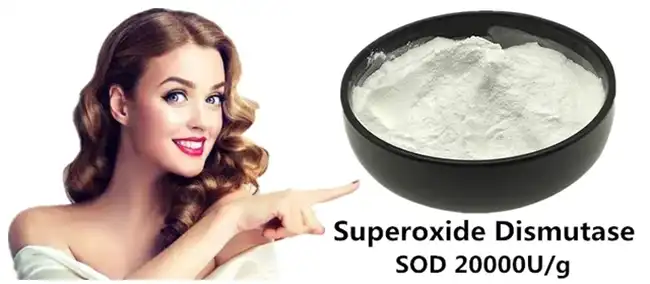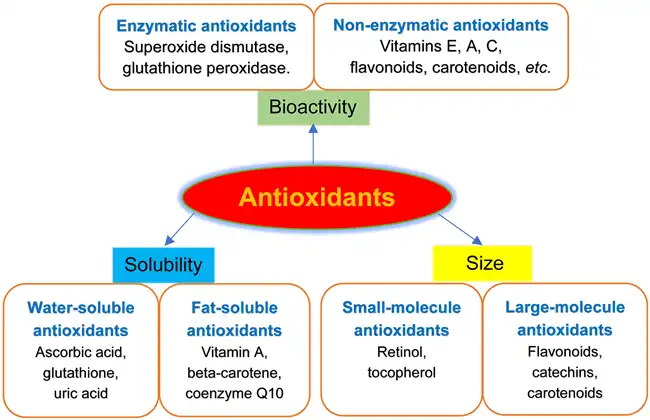Superoxide Dismutase Powder vs. Other Antioxidants: What’s the Difference?
2024-12-11 10:49:10
In the world of antioxidants, superoxide dismutase (SOD) powder stands out as a powerful contender. But how does it compare to other well-known antioxidants like vitamins C and E? Let's dive into the fascinating world of antioxidants and uncover what makes superoxide dismutase powder unique.
What is Superoxide Dismutase and How Does It Function as An Antioxidant?
Superoxide dismutase is an enzyme naturally produced by our bodies. It's our first line of defense against harmful superoxide radicals, which are highly reactive oxygen species that can damage cells and contribute to aging and various diseases.
SOD functions by catalyzing the dismutation of superoxide into oxygen and hydrogen peroxide. This process effectively neutralizes the superoxide radical, preventing it from causing oxidative stress and cellular damage. The resulting hydrogen peroxide is then further broken down by other enzymes like catalase and glutathione peroxidase.
What's remarkable about SOD is its efficiency. It can catalyze the neutralization of superoxide radicals at an incredibly rapid rate, making it one of the most potent antioxidants known to science. This efficiency is crucial because superoxide radicals are constantly being produced in our bodies as a byproduct of normal cellular metabolism.
While our bodies produce SOD naturally, levels can decrease with age or due to various environmental factors. This is where supplementation with superoxide dismutase powder comes into play. By boosting SOD levels, we can enhance our body's natural antioxidant defenses.
How does Superoxide Dismutase Compare to Vitamins C and E in Antioxidant Activity?
Vitamins C and E are well-known antioxidants that have been studied extensively. While they're undoubtedly beneficial, superoxide dismutase offers some unique advantages:
- Specificity: SOD is highly specific in its action, targeting superoxide radicals exclusively. This specificity allows it to be incredibly efficient at neutralizing these particular free radicals. In contrast, vitamins C and E have a broader spectrum of action, neutralizing various types of free radicals but potentially with less efficiency for any specific type.
- Catalytic nature: Unlike vitamins C and E, which are consumed in the process of neutralizing free radicals, SOD acts as a catalyst. This means it can continue to function without being depleted, potentially offering longer-lasting protection.
- Intracellular action: SOD operates within cells, where much of the oxidative damage occurs. Vitamins C and E, on the other hand, primarily work in extracellular spaces or cell membranes.
- Synergistic effects: While SOD is powerful on its own, it also works synergistically with other antioxidants. For example, the hydrogen peroxide produced by SOD's action on superoxide radicals is further neutralized by other antioxidants like glutathione peroxidase.
It's important to note that while superoxide dismutase bulk powder offers these unique benefits, vitamins C and E remain crucial for overall health and antioxidant protection. A balanced approach incorporating various antioxidants is likely the most beneficial strategy for optimal health.
How do the Mechanisms of Action Differ Between Superoxide Dismutase and Other Antioxidants?
The mechanisms of action for different antioxidants can vary significantly, which is why a diverse antioxidant strategy is often recommended. Let's compare SOD's mechanism to some other common antioxidants:
- Superoxide Dismutase: As mentioned earlier, SOD catalyzes the conversion of superoxide radicals into oxygen and hydrogen peroxide. This catalytic action allows SOD to neutralize many superoxide molecules without being consumed in the process.
- Vitamin C (Ascorbic Acid): Vitamin C donates electrons to neutralize various types of free radicals. In this process, vitamin C itself becomes oxidized, forming dehydroascorbic acid. This means vitamin C is consumed as it neutralizes free radicals, unlike superoxide dismutase powder's catalytic action.
- Vitamin E (Tocopherols): Vitamin E primarily protects cell membranes from lipid peroxidation. It donates hydrogen atoms to free radicals, neutralizing them and becoming a relatively stable radical itself. This radical form of vitamin E can then be regenerated by other antioxidants like vitamin C.
- Glutathione: This tripeptide acts as an antioxidant by donating an electron to neutralize free radicals. It can also act as a cofactor for antioxidant enzymes and help regenerate other antioxidants like vitamins C and E.
- Carotenoids (like beta-carotene): These antioxidants can quench singlet oxygen, a type of reactive oxygen species. They can also neutralize free radicals by accepting unpaired electrons.
The unique mechanism of SOD makes it particularly effective against superoxide radicals, which are among the most common and harmful free radicals in our bodies. However, each antioxidant plays a crucial role in our overall antioxidant defense system.
Superoxide dismutase powder offers a potent and specific antioxidant action that complements other antioxidants. Its ability to catalytically neutralize superoxide radicals makes it a valuable addition to any antioxidant regimen. While vitamins C and E and other antioxidants remain important, the unique properties of SOD make it a standout player in the fight against oxidative stress.
Conclusion
Understanding the differences between these antioxidants can help in developing more effective strategies for combating oxidative stress and promoting overall health. As research continues, we may uncover even more about the unique benefits of superoxide dismutase powder and how it can be best utilized alongside other antioxidants for optimal health outcomes.
Contact Us
Are you interested in incorporating superoxide dismutase powder into your health regimen? XAZB Biotech offers high-quality, pure superoxide dismutase bulk powder. For more information or to place an order, please contact us at Jessica@xazbbio.com. Our team of experts is ready to answer any questions you may have about this powerful antioxidant. Our factory also can supply OEM/ODM One-stop service,including customized packaging and labels.
References
1. Fridovich, I. (1995). Superoxide radical and superoxide dismutases. Annual Review of Biochemistry, 64, 97-112.
2. Halliwell, B., & Gutteridge, J. M. C. (2015). Free Radicals in Biology and Medicine. Oxford University Press.
3. Younus, H. (2018). Therapeutic potentials of superoxide dismutase. International Journal of Health Sciences, 12(3), 88-93.
4. Ighodaro, O. M., & Akinloye, O. A. (2018). First line defence antioxidants-superoxide dismutase (SOD), catalase (CAT) and glutathione peroxidase (GPX): Their fundamental role in the entire antioxidant defence grid. Alexandria Journal of Medicine, 54(4), 287-293.
5. Pisoschi, A. M., & Pop, A. (2015). The role of antioxidants in the chemistry of oxidative stress: A review. European Journal of Medicinal Chemistry, 97, 55-74.
6. Fukai, T., & Ushio-Fukai, M. (2011). Superoxide dismutases: role in redox signaling, vascular function, and diseases. Antioxidants & Redox Signaling, 15(6), 1583-1606.
Send Inquiry
You may like




